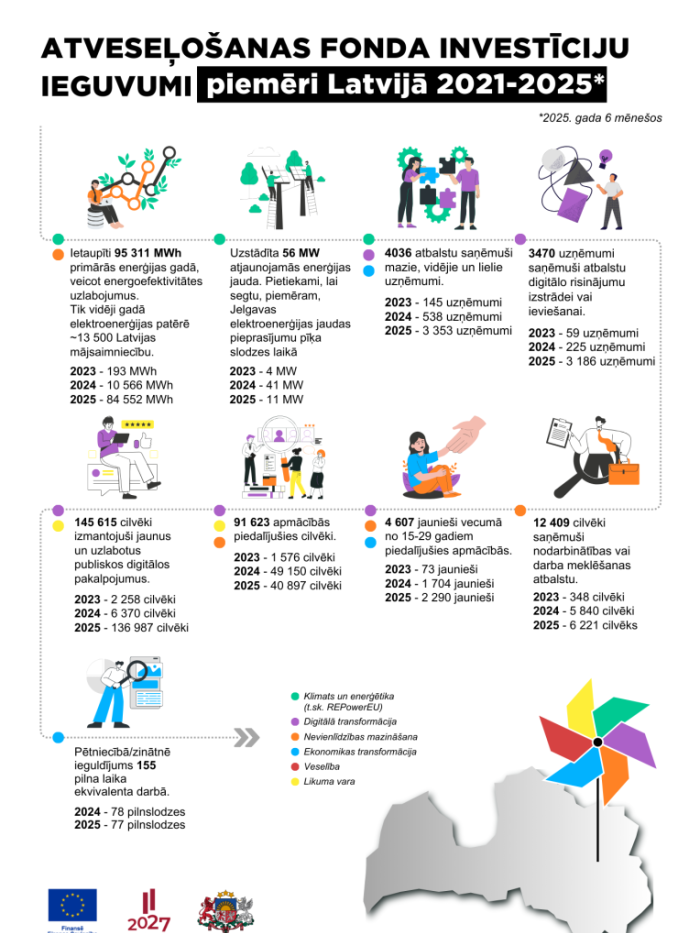On Tuesday, 16 September, a remote quarterly meeting was held between representatives of the Ministry of Finance (MF) and the European Commission (EC) on the progress of the Recovery and Resilience Facility (RRF) implementation – the indicators achieved so far and those to be achieved by the end of the year. Several changes to Latvia’s Recovery and Resilience Plan were discussed at the meeting, mainly simplifying the justification for the achievement of indicators, which is being done at the initiative of the EC. The aim is to reduce the administrative burden on both the EC and Latvia, without significantly reducing the ambition of the targets set in the Recovery and Resilience Plan. Latvia is ready to submit a payment request to the EC this year for additional indicators that have been achieved ahead of schedule. The EC also expressed its conceptual support for most of the clarifications proposed by Latvia, which will help to ensure that the planned objectives are achieved.
“The implementation of Latvia’s Recovery and Resilience Plan reforms and investments totaling EUR 1.97 billion is proceeding according to plan, with certain parts of the plan being clarified in cooperation with the European Commission where necessary. The projects are being actively implemented and risks are being managed with strict monitoring discipline. The reallocation of funding serves as an important tool for the effective management of both the Recovery and Resilience Facility and the EU funds investment portfolio, ensuring the optimal use of resources. The planned amendments will reduce the administrative burden and allow for more effective use of the Facility’s resources. The amendments to the Recovery and Resilience Plan are expected to be submitted to the European Commission by November this year, following their approval by the government,” Armands Eberhards, Deputy State Secretary for EU Funds at the Ministry of Finance, emphasized at the meeting.
In the final phase of Latvia’s Recovery and Resilience Plan, there has been a significant increase in the pace of investment. By September 2025, contracts worth EUR 1.8 billion, or 93% of the total allocation, had been concluded, EUR 933 million, or 47%, had been paid to project implementers, and 60% of the targets set in the Recovery and Resilience Plan had been achieved. As a result of the 90 indicators achieved in the first three years, Latvia has already received more than EUR 1 billion, or approximately 55% of the total allocation, in state budget revenue from the EC. All project and plan indicators must be achieved by the end of August 2026. At the end of 2025, Latvia plans to submit a fourth payment request to the EC for at least €302 million for the indicators achieved. The final payment request must be submitted to the EC no later than by the end of September 2026.
The amendments currently being prepared cover several areas of the Recovery and Resilience Plan – climate and environment, digital transformation, reduction of social inequalities, health, strengthening of the economy and the rule of law. They mainly provide for simplifications in supporting documents, clarification of initial indicators, faster reporting on implementation where possible or extension of deadlines where necessary, as well as expansion of the circle of beneficiaries and other measures. The amendments also include specific financial reallocations for the benefit of Latvian residents and objectives that are important for economic development – part of the funds for the development of digital skills will be redirected to schools for the necessary teaching equipment, part of the funding for long-term care measures will be allocated to the development of low-rent housing, while support for energy efficiency in businesses will be allocated to the modernization of the electricity supply network.
Constructive discussions with the EC are continuing on individual RRF measures to ensure optimal solutions and implementation of the measures.
To date, by fulfilling targets and implementing projects, significant results for society have been achieved in all areas of the RRF. For example, the first publicly accessible biomethane entry point in Latvia has been established and opened in Džūkste, which is a significant step in the development of biomethane production. To reduce flood risks, the Mazā Jugla polder protective dam has been renovated, and renovation of the Ogre polder protective dam began in the summer. Investments were made in spinal surgery at the North Kurzeme Regional Hospital, making it one of the leading spinal surgery centers in Latvia. The Latvian Biomedical Research and Study Center has created a genome reference for more than 3,500 Latvian residents with secure data access throughout Europe, promoting the development of personalized disease diagnostics.
It has already been reported that in 2025 and 2026, annual investment volumes (RRF together with EU funds) in Latvia will be at an all-time high, exceeding one billion euros, which is almost twice as much as in previous periods.
Latvia’s Recovery and Resilience Plan provides for reforms and investments in areas such as climate and energy, including transport infrastructure, digital transformation, reducing inequality, innovation and scientific development, health, and the development of the rule of law. In contrast to EU funds, in order for EU Member States to receive RRF money in their budgets, they must first implement reforms and projects, achieving certain indicators in accordance with their Recovery and Resilience Plans.



